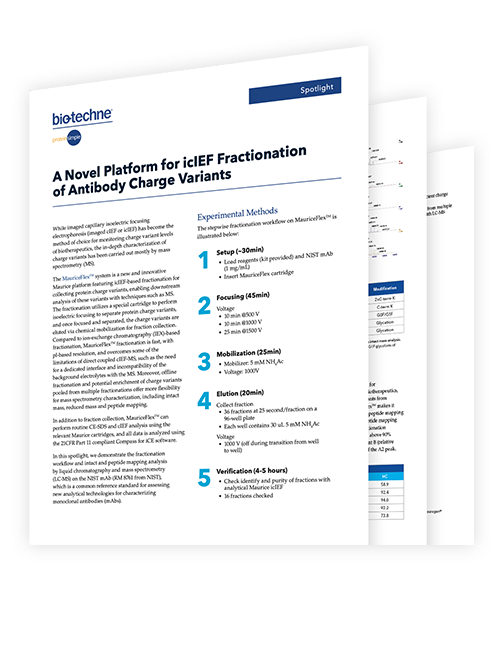灵活分析,应用自由
隆重推出 MauriceFlex,您的蛋白质电荷变异体组分分离和收集的最佳方案:
- 应用自由:组分收集后可进行完整分子量、还原型质谱、肽图等分析
- 劳动自由:无需色谱柱即可轻松收集高纯度组分,远离劳动密集型的 IEX 工作流程
- 功能自由: 一站式 icIEF、CE-SDS 和 icIEF 组分收集平台
- 时间自由: 不到一天时间,即可完成鉴定、电荷变异体组分分离和收集,省时高效
目录
- 还在使用 IEX 或 HPLC 进行蛋白质电荷变异体组分分离?
- 特色资源
- MauriceFlex icIEF 组分收集工作流程
- MauriceFlex icIEF 组分收集原理
- 哪款 Maurice 适合您?
MauriceFlex 一站式提供蛋白质电荷变异体组分分离和收集、全柱成像毛细管等电聚焦 (icIEF) 和 CE-SDS 模块,不拘于常规分子量大小和电荷应用,MauriceFlex 可实现对您的分子在任何阶段进行深入分析,无需依赖其他方法,例如 IEX 和 HPLC。
特色资源
哪款 Maurice 适合您?
|
系统 |
Maurice |
Maurice C. |
Maurice S. |
MauriceFlex |
|---|---|---|---|---|
|
icIEF 应用(按电荷分离) |
是 |
是 |
否 |
是 |
|
CE-SDS 应用(按分子量分离) |
是 |
否 |
是 |
是 |
| icIEF 组分收集 | 否 | 否 | 否 | 是 |
|
紫外吸收检测 |
是 |
是 |
是 |
是 |
|
自发荧光检测 |
是 |
是 |
否 |
是 |
|
在线预混(OBM) |
是 |
是 |
否 |
否 |
技术规格
|
说明 |
cIEF |
CE-SDS PLUS |
Turbo CE-SDS |
icIEF 分级 |
|---|---|---|---|---|
|
最小样本量 |
50 µL |
50 µL |
100 µL |
100 µL |
|
进样方式 |
真空 |
电动 |
电动 |
真空 |
|
典型分离时间 |
6-10 分钟(取决于分子) |
还原型 IgG:25 分钟;未还原型 IgG:35 分钟 |
还原型 IgG:5.5 分钟;未还原型 IgG:8 分钟 |
40 - 50 分钟(取决于分子) |
| 检测方式 | 280 nm 处紫外吸光度 荧光:激发波长 (Ex) 280 nm,发射波长 (Em) 320-450 nm |
220 nm 处紫外吸光度 | 220 nm 处紫外吸光度 | 荧光:激发波长 (Ex) 280 nm, 发射波长 (Em) 320-450 nm |
|
典型电压 |
预聚焦:1500 V |
分离:5750 V |
分离:4200 V |
预聚焦:500 V 和 1000 V 聚焦:1500 V |
|
进样次数/卡盒 |
质保 100 次,最多 200 次(最多 25 批) |
质保 100 次,最多 500 次(最多 25 批) |
质保 100 次(最多 25 个批) |
最多 15 次进样 |
|
每批最多进样次数 |
100 |
48 |
96 |
1(分级) 4 (icIEF) |
|
pI/分子量范围 |
2.85-10.45 |
10-270 kDa |
10-270 kDa |
3-10 |
|
pI/分子量分析 CV |
1% |
≤2% |
<2% |
1% |
|
>10% 组成的峰的 CV |
≤5%(批内),≤6%(批间) |
不适用 |
不适用 |
≤10%(批间) |
| 相对迁移时间 CV | 不适用 | 还原型 IgG <1% | <5% | 不适用 |
|
pI/分子量分辨率 |
0.05 个 pl 单位(宽范围 3-10 两性电解质) |
≥ 1.5(NGHC/HC IgG 标准品) |
≥ 1.0(NGHC/HC IgG 标准品) |
不适用 |
|
动态范围 |
2 个数量级 |
2 个数量级 |
2 个数量级 |
不适用 |
|
线性 |
>0.995 |
>0.995 |
>0.995 |
不适用 |
|
灵敏度 (LOD) |
0.7 µg/mL(天然荧光) |
0.3 µg/mL |
0.6 μg/mL(基于内标的值) |
不适用 |
|
样本盘选择 |
96 孔板或 48 样品管 |
96 孔板或 48 样品管 |
96 孔板或 48 样品管 |
仅 96 孔板 |
|
功率 |
100 V-240 V (AC),50/60 Hz,500 W |
100 V-240 V (AC),50/60 Hz,500 W |
100 V-240 V (AC),50/60 Hz,500 W |
100 V-240 V (AC),50/60 Hz,500 W |
| 电压范围 | 0–6,500 V | 0–6,500 V | 0–6,500 V | 0–6,500 V |
|
温度控制范围 |
4-25℃ |
4-25℃ |
4-25℃ |
10-25℃ |
|
尺度 |
44cm H x 42cm W x 61cm D |
44cm H x 42cm W x 61cm D |
44cm H x 42cm W x 61cm D |
44cm H x 42cm W x 61cm D |
|
重量 |
46 kg (100 lb) |
46 kg (100 lb) |
46 kg (100 lb) |
46 kg (100 lb) |







